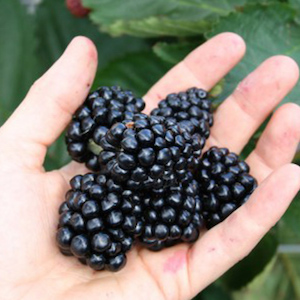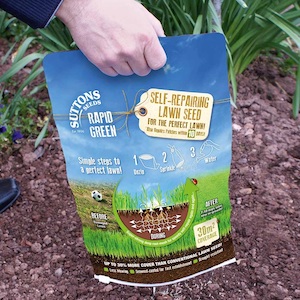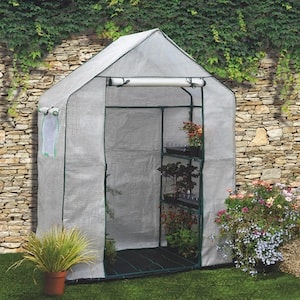What to do in your garden in September
For an easy guide to gardening in September, our quick checklist of jobs will keep your garden looking its best. Autumn heralds the arrival of shorter days and cooler weather, but there’s still plenty of time to enjoy homegrown harvests from the vegetable patch. If you want to keep growing your own crops over the winter, see our collection of vegetable seeds to sow in September. It’s also the perfect time to fill your containers with winter pansies, plant your spring flowering bulbs for next year, and choose from a wide range of flower seeds you can still sow in September.
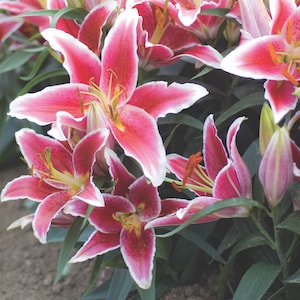
Image: NEW Lily bulbs ‘Dazzler’
Flowering plants in September
- Plant your spring flowering bulbs this month, apart from tulips which are better planted in November.
- Plant winter and early spring flowers such as bellis (daisy), pansy, polyanthus, primrose and wallflowers once your summer bedding plants are over.
- Sow hardy annual seeds outdoors like calendula, wallflower, godetia, larkspur, love-in-a-mist (nigella) and eschscholzia (poppy).
- Direct sow native wild flowers. Try field scabious, field cornflower and feverfew.
- Sow the wild flowers primrose and cowslip in a cold frame.
- Sow sweet peas in a cold frame or unheated greenhouse to over-winter. Plant the young plants out in March/April for early blooms.
- Sow cyclamen, geranium, schizanthus and strelitzia (bird of paradise) seeds in the greenhouse now for overwintering.
- Revive dormant cyclamen plants by repotting the root ball into a slightly bigger pot with fresh compost and watering well.
- Deadhead the last rose blooms of the summer. Cut back taller stems slightly to reduce the risk of stems snapping in windy conditions over the winter.
- Take stem cuttings from your favourite roses at the beginning of this month. Choose a healthy flower-free stem and cut from the plant using clean sharp secateurs. Remove the growing tip just above a leaf joint and remove all of the leaves apart from the top three. Place the cutting directly into the soil approximately 30cm (12″) to about half its length, either in a pot or straight out in the garden.
- Support gladioli and other tall summer flowering bulbs as they flower. Cut a few stems to display in a vase indoors.
- Apply nematodes to plants infested with thrips. Once flowering has finished, gladioli corms may be lifted, cleaned and carefully stored for planting out again next spring.
- Tie dahlia flower stems to plant supports to prevent them breaking in the wind. Keep deadheading spent flowers, and cut a few fresh flowers to display indoors.
- Plant lily bulbs from September onwards for glorious scent and colour next summer.
- Divide large herbaceous perennial plants in the border now. Pot up the new plants in containers or plant through the bed. Use a large fork to gently tease entangled roots apart.
Vegetables in September
- Plant onion sets to over-winter from the middle of the month onwards.
- Sow winter lettuce seeds, especially ‘Brighton’ and ‘Winter Density’. Try a cut-and-come again salad variety in pots for quick tasty leaves in the autumn.
- Lift maincrop potatoes and allow them dry prior to storing in wooden trays in a dark, cool, frost-free shed or garage.
- Sow late season seed potatoes this month for a harvest of new potatoes at Christmas.
- Transplant spring cabbages like ‘F1 Winter Jewel’ into their final positions.
- Pot up plants of basil, marjoram, mint, oregano and parsley and grow them on the kitchen windowsill for a supply of herbs during the winter.
- Pick vegetable crops like courgettes and beans regularly while they are fresh and tender.
- Water tomatoes and chillies grown under glass or in the greenhouse as they continue to produce crops.
- Carefully harvest celery plants with a hand fork as they reach a good size.
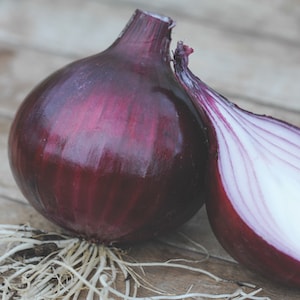
Image: Onion ‘Electric’
Fruit in September
- Grow new blackberry plants by burying the fresh growing tips in the surface of the soil. They will quickly form roots and new shoots will develop next spring. Separate the new blackberry plants and plant up where required.
- Avoid wasp damage to early fruiting apple trees by hanging wasp traps or imitation nests in the branches of the trees. Harvest the fruit from these early ripening apple varieties as soon as they’re sweet enough to eat.
- Harvest ripe fruit from your peach trees this month.
- Cover ripening crops of raspberries, blackberries and other autumn-fruiting varieties with mesh to keep birds away. Check the netting daily to make sure no wildlife has become trapped.
Pots, baskets, and containers in September
- Water your patio container plants daily if possible.
- Keep deadheading spent blooms to keep displays looking fresh.
- Pot up your favourite tender perennial plants to overwinter for next year. Keep plants in a frost free place over winter, and cut back foliage by a third to encourage compact, bushy plants next spring.
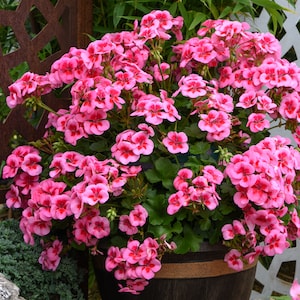
Image: Geranium Sunrise Smoky Eye Pink
September lawn care
- Sow a new lawn or repair an existing one using special repair lawn seed this month.
- Reduce the frequency of mowing to keep grass looking good as growth rates slow.
- Use a lawn scarifier or a suitable lawn rake to keep the lawn clear of fallen leaves and thatching.
- Apply a top dressing on an established lawn. First aerate by spiking with an aerator or fork and apply an autumn fertiliser or light layer of topsoil. Use this opportunity to fill and level any uneven ground.
General September garden jobs
- Clean out greenhouses and cold frames by removing algae and dirt from the glass and the frame. This increases the amount of light that reaches your plants and reduces the build up of pests and diseases.
- Keep on top of watering in the greenhouse on hot days, remembering to open vents and doors to regulate the temperature.

Image: Shutterstock
September pond care
- Remove pond debris using a net, rake or pond vac to keep the pond clear and maintain high oxygen levels.
- Place a net over the pond to catch falling leaves before they enter the water.
- Check pond filters and pumps regularly to see if they need cleaning.
- Siphon off around a quarter of the water in the pond and replace it with fresh water if your fish stocks are high.
- Give fish a high-protein feed to build up strength in preparation for the winter.
Suttons Seeds recommend these areas which may also be of interest.
More Monthly Gardening Tasks by Month
- Previous month: Jobs to do in your garden in August
- Next month: Jobs to do in your garden in October


